高三英语总复习语法系列训练主谓一致的测试热点[下学期]
文档属性
| 名称 | 高三英语总复习语法系列训练主谓一致的测试热点[下学期] | 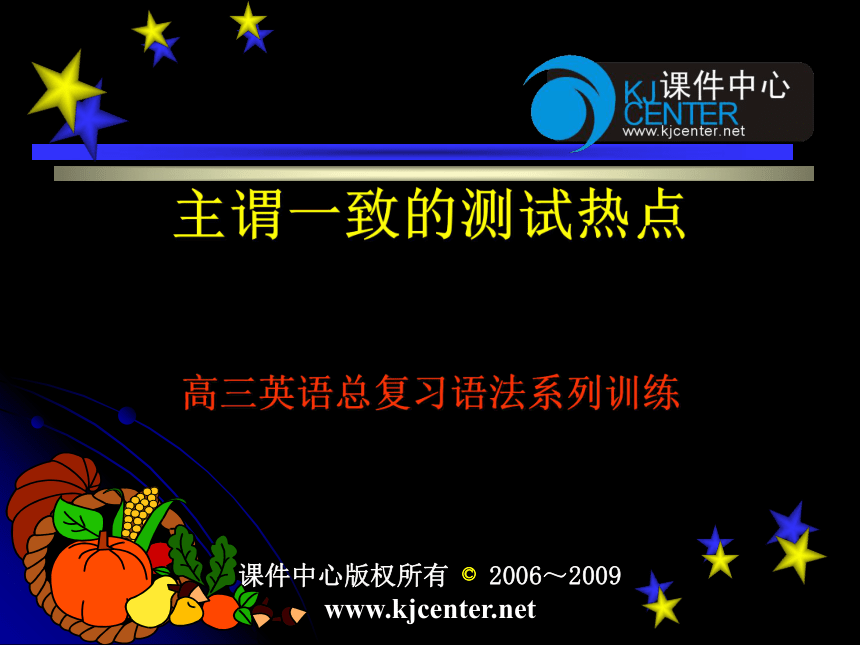 | |
| 格式 | rar | ||
| 文件大小 | 1.2MB | ||
| 资源类型 | 教案 | ||
| 版本资源 | 通用版 | ||
| 科目 | 英语 | ||
| 更新时间 | 2006-07-27 09:47:00 | ||
图片预览


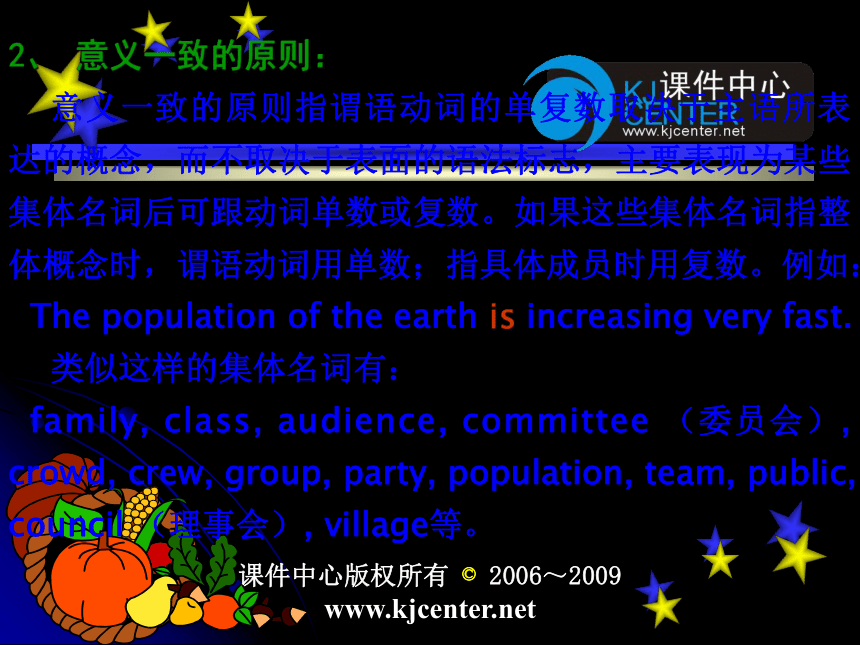
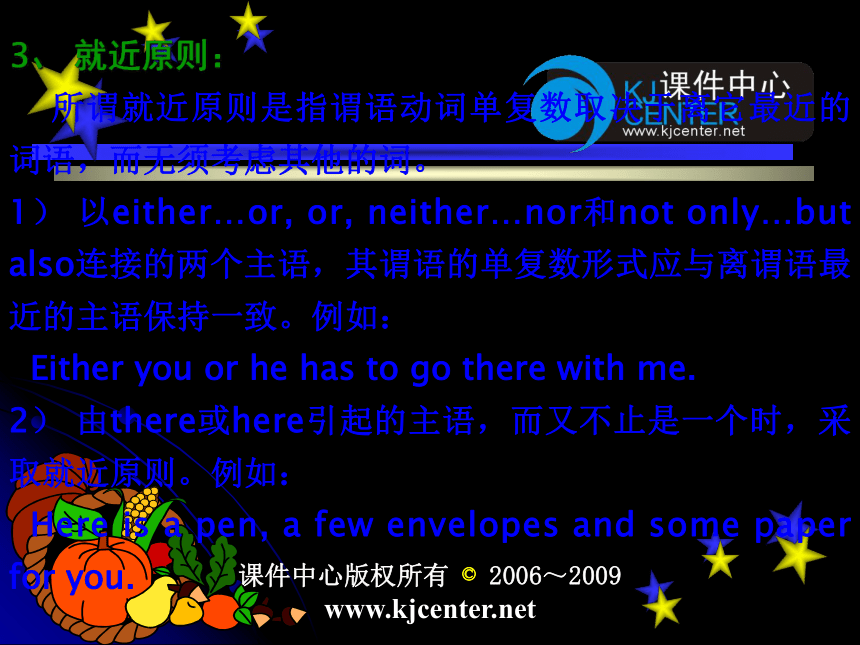

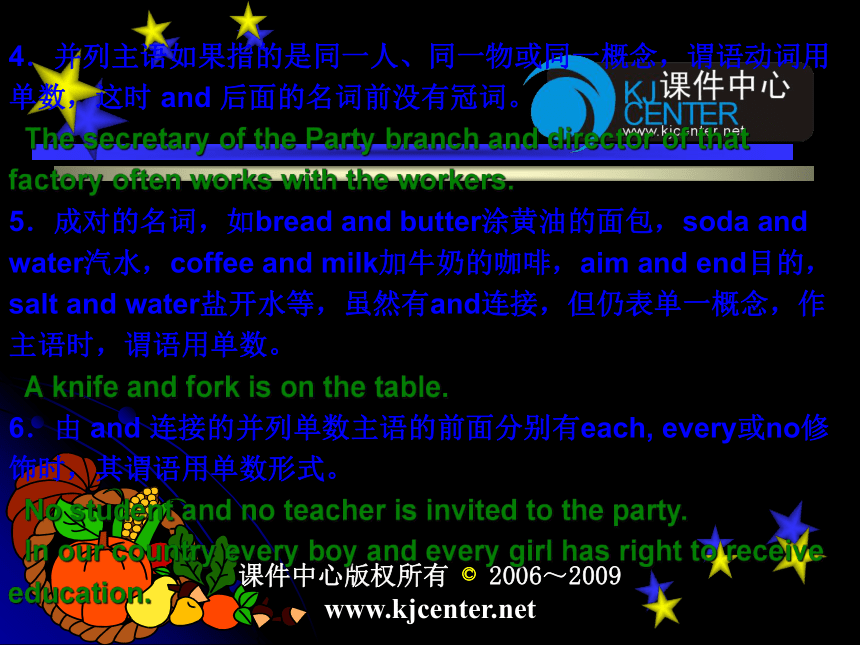
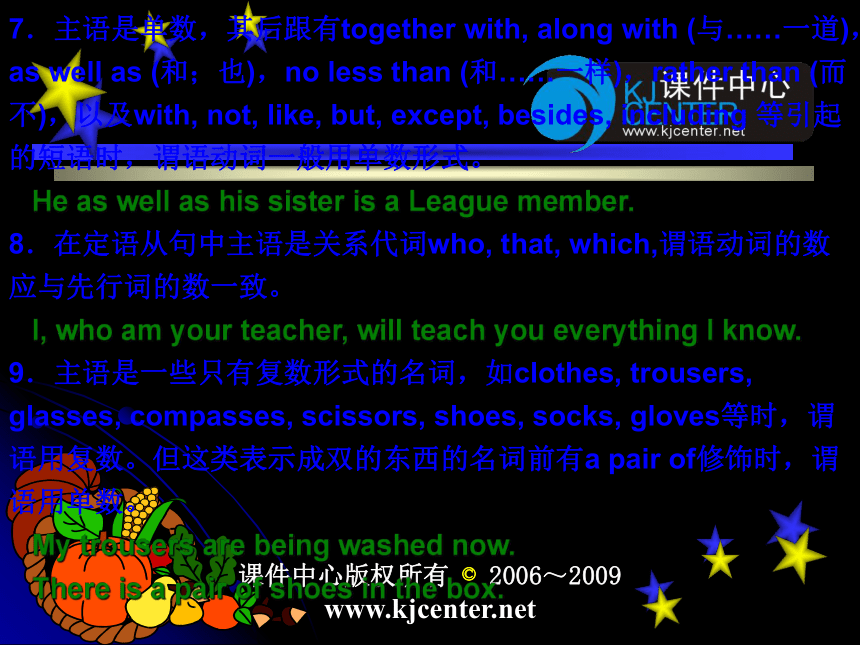
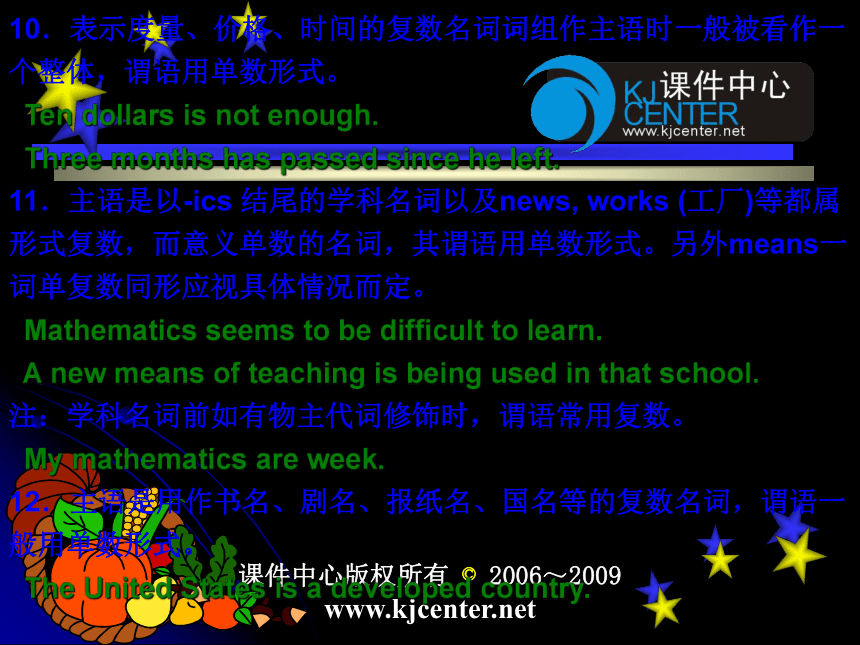
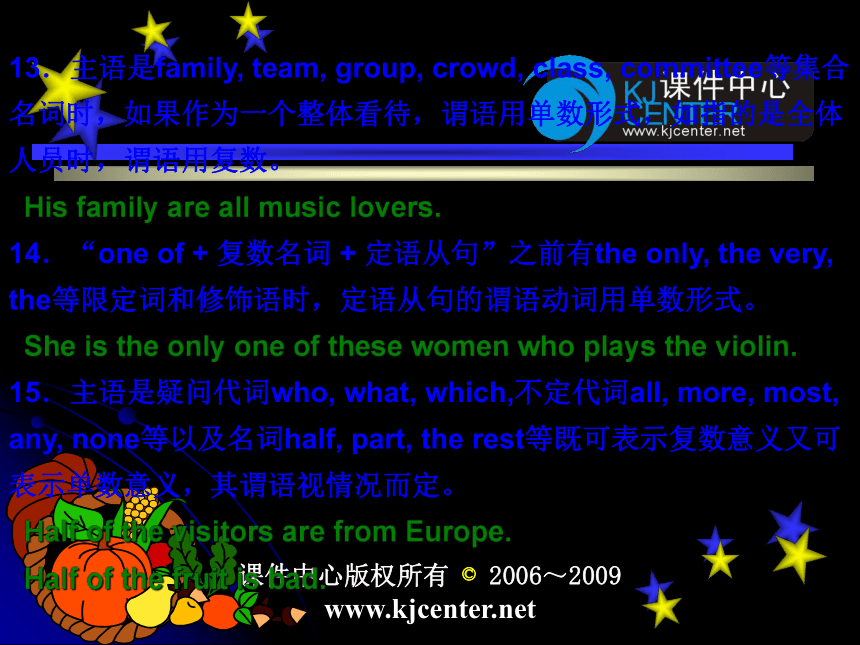

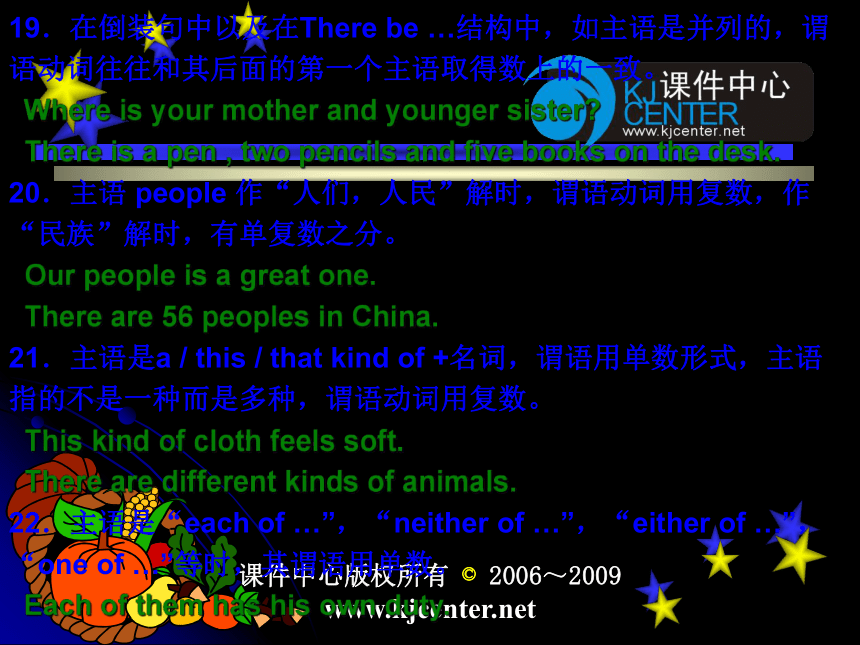
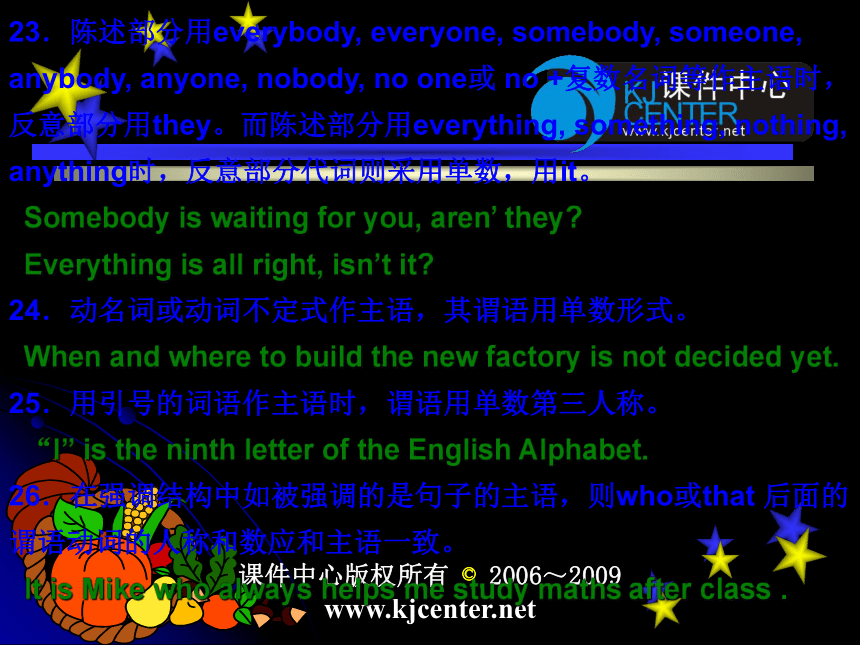
文档简介
课件46张PPT。主谓一致的测试热点
高三英语总复习语法系列训练
主谓一致是指句中的主语和谓语的致。我们一般遵从三个原则:
1、 语法一致的原则:
语法一致的原则是指主语为单数或复数时,其谓语动词要与其相呼应。但我们要注意一些特殊情况;
1)以along with, together with, with, as well as, accompanied by, rather than, but, except 连接的两个主语,其谓语的单复数以第一个主语为主。例如:
Several passengers, together with the driver, were hurt.
2)表示时间,重量,长度,价格等的复数名词,作主语从整体来看时,谓语动词用单数。例如:
Fifty years is not a long time.
3) 非谓语动词,从句或其他短语作主语,谓语动词用单数形式。
例如:
Early to bed and early to rise is healthful.
4)如果主语是由and连接的两个单数名词,但前面有each, every, no 等词修饰时,谓语用单数。例如:
Every boy and girl in this region is taught to read and write.2、 意义一致的原则:
意义一致的原则指谓语动词的单复数取决于主语所表达的概念,而不取决于表面的语法标志,主要表现为某些集体名词后可跟动词单数或复数。如果这些集体名词指整体概念时,谓语动词用单数;指具体成员时用复数。例如:
The population of the earth is increasing very fast.
类似这样的集体名词有:
family, class, audience, committee (委员会), crowd, crew, group, party, population, team, public, council (理事会), village等。3、 就近原则:
所谓就近原则是指谓语动词单复数取决于离它最近的词语,而无须考虑其他的词。
1) 以either…or, or, neither…nor和not only…but also连接的两个主语,其谓语的单复数形式应与离谓语最近的主语保持一致。例如:
Either you or he has to go there with me.
2) 由there或here引起的主语,而又不止是一个时,采取就近原则。例如:
Here is a pen, a few envelopes and some paper for you.主谓一致的测试热点1.由 many a 或 more than + 单数名词作主语时,其谓语用单数形式。
Many a foreigner has been to the Great Wall.
More than one student has visited the exhibition.
2.“……的几分之几”和“……的百分之几” 作主语时,其谓语用单数或复数取决于 of 后的名词。
Three-fourths of the surface of the earth is sea.
40 percent of the students in our class are girls.
3.“a number of + 名词复数”作主语,谓语用复数;
“ the number of + 名词复数”作主语,谓语用单数。
A number of pupils like reading picture-books.
The number of the students in our class is 55. 4.并列主语如果指的是同一人、同一物或同一概念,谓语动词用单数,这时 and 后面的名词前没有冠词。
The secretary of the Party branch and director of that factory often works with the workers.
5.成对的名词,如bread and butter涂黄油的面包,soda and water汽水,coffee and milk加牛奶的咖啡,aim and end目的,salt and water盐开水等,虽然有and连接,但仍表单一概念,作主语时,谓语用单数。
A knife and fork is on the table.
6.由 and 连接的并列单数主语的前面分别有each, every或no修饰时,其谓语用单数形式。
No student and no teacher is invited to the party.
In our country every boy and every girl has right to receive education. 7.主语是单数,其后跟有together with, along with (与……一道),as well as (和;也),no less than (和……一样),rather than (而不),以及with, not, like, but, except, besides, including 等引起的短语时,谓语动词一般用单数形式。
He as well as his sister is a League member.
8.在定语从句中主语是关系代词who, that, which,谓语动词的数应与先行词的数一致。
I, who am your teacher, will teach you everything I know.
9.主语是一些只有复数形式的名词,如clothes, trousers, glasses, compasses, scissors, shoes, socks, gloves等时,谓语用复数。但这类表示成双的东西的名词前有a pair of修饰时,谓语用单数。
My trousers are being washed now.
There is a pair of shoes in the box. 10.表示度量、价格、时间的复数名词词组作主语时一般被看作一个整体,谓语用单数形式。
Ten dollars is not enough.
Three months has passed since he left.
11.主语是以-ics 结尾的学科名词以及news, works (工厂)等都属形式复数,而意义单数的名词,其谓语用单数形式。另外means一词单复数同形应视具体情况而定。
Mathematics seems to be difficult to learn.
A new means of teaching is being used in that school.
注:学科名词前如有物主代词修饰时,谓语常用复数。
My mathematics are week.
12.主语是用作书名、剧名、报纸名、国名等的复数名词,谓语一般用单数形式。
The United States is a developed country. 13.主语是family, team, group, crowd, class, committee等集合名词时,如果作为一个整体看待,谓语用单数形式,如指的是全体人员时,谓语用复数。
His family are all music lovers.
14.“one of + 复数名词 + 定语从句”之前有the only, the very, the等限定词和修饰语时,定语从句的谓语动词用单数形式。
She is the only one of these women who plays the violin.
15.主语是疑问代词who, what, which,不定代词all, more, most, any, none等以及名词half, part, the rest等既可表示复数意义又可表示单数意义,其谓语视情况而定。
Half of the visitors are from Europe.
Half of the fruit is bad. 16.主语是表示数量的“one and a half +复数名词”,其谓语用单数形式。主语是“one or two + 复数名词”,其谓语用复数形式。
One and a half bananas is left on the table.
There are one or two things I‘d like to know about.
17.the +形容词或分词作主语时,如指一类人。其谓语用复数,如指抽象概念,其谓语用单数。如:
The rich are not always happy.
The new is sure to replace the old.
18.由not only … but also, neither…nor, either…or, not …but以及or连接的并列主语,谓语动词要与最靠近它的主语在数上保持一致。
Not only your father’s friends but also your father likes smoking.19.在倒装句中以及在There be …结构中,如主语是并列的,谓语动词往往和其后面的第一个主语取得数上的一致。
Where is your mother and younger sister?
There is a pen , two pencils and five books on the desk.
20.主语 people 作“人们,人民”解时,谓语动词用复数,作“民族”解时,有单复数之分。
Our people is a great one.
There are 56 peoples in China.
21.主语是a / this / that kind of +名词,谓语用单数形式,主语指的不是一种而是多种,谓语动词用复数。
This kind of cloth feels soft.
There are different kinds of animals.
22.主语是“each of …”,“neither of …”,“either of …”,“one of?…”等时,其谓语用单数。
Each of them has his own duty. 23.陈述部分用everybody, everyone, somebody, someone, anybody, anyone, nobody, no one或 no +复数名词等作主语时,反意部分用they。而陈述部分用everything, something, nothing, anything时,反意部分代词则采用单数,用it。
Somebody is waiting for you, aren’ they?
Everything is all right, isn’t it?
24.动名词或动词不定式作主语,其谓语用单数形式。
When and where to build the new factory is not decided yet.
25.用引号的词语作主语时,谓语用单数第三人称。
“I” is the ninth letter of the English Alphabet.
26.在强调结构中如被强调的是句子的主语,则who或that 后面的谓语动词的人称和数应和主语一致。
It is Mike who always helps me study maths after class .27.wish后接宾语从句用虚拟语气,如表示与现在事实相反,无论主语是单数还是复数,be动词用were。
I wish I were ten years younger.
28.police, cattle等集合名词作主语时,谓语用复数。
The murderer has run away. The police are searching for him.
29.算式中表示数目的主语通常看作单数,其谓语常用单数形式,也可用复数。
Five times four is twenty.
30.youth作“青年们”解作主语时,谓语用复数。
The youth of China today are doing their best to study modern science and technology. 主谓一致精练与解析1.More than one person here ____ with the disease.
A. has been infected B. have been infected
C. has been infecting D. have been infecting●由more than one 修饰单数名词作主语时,谓语动词要用单数又如:More than one man was injured in the accident.
More than one house has been repaired.2. One or perhaps more pages _____ missing.
A. is B. are C. has been D. have been●由or连接两个名词或代词作主语时,谓语动词应与靠近它的
主语一致。
又如:Are you or he to drive ?
Was she or you there ?3.An expert, together with some assistants, ____ to help in this
work.
A. was sent B. were sent C. is sending D. are sending●由 with,together with,along with,rather than,no less than ,
but, besides,except等连接两个名词或代词作主语时,谓语动词应与前一个相一致。又如:Nobody but John and Helen was absent.
I, rather than you, am responsible for the accident.4.The police ____ the black in winter.
A. wears B. wear C. put on D. puts on●英语中,一些表示总称意义的名词,如:police,people,cattle等作主语时,谓语动词要用单数形式。又如:Some people spend a lot of money on clothes.
Cattle are raised everywhere by the farmers.5.The number of students that you have met ____ the life of the team.
A. are B. is C. were D. be●the number of+复数名词作主语时,谓语用单数。a number
of+复数名词作主语时,谓语用复数。
又如:The number of cars is increasing in Beijing.
A number of books have been published on this subject.6. To get up early and to go to sleep early ____ good for your health.
A. is B. are C. was D. were●由and连接两个名词,包括两个不定式、两个动名词作主语,若指同一件事或一个概念事,谓语动词用单数形式。又如:Whether to go on or return is not known.
Time and tide waits for no man.7. More students than one _______.
A. were punished B. is punished
C. was punished D. will punish●More +复数名词 +than one +和 more than one +单数名词的意义相同,均表示“不只一个”,但前者用作复数,后者用作单数。又如:More students than one were punished.
=More than one student was punished.8. What they need _____ more people.
A. is B. are C. has D. have● 名词从句作主语时,通常表示单数概念,谓语动词常用单数,
但所指内容是复数意义时,谓语动词用复数。本句从表语more people 可以得知主语what we need指复数内容。 又如:What we need is more time.
What he needs are books.
What he says and what he does do not agree. 主谓一致 练习 历年高考题 例题(4) 用 连接的并列主语被each,every或no修饰时,谓语动词 用单数。(5) each of + 复数代词,谓语动用单数。复数代词+each,谓语动词用单数。如 语法一致语法一致 语法一致语法一致语法一致语法一致内容 一致内容 一致内容 一致内容 一致内容 一致就近一致就近 一致 Example
E-mail, as well as telephones, ____ an important part in
daily communication. (99 上海2)
A. is playing B. have played
C. are playing D. play答案及分析答案是C。当有as well as 引导时,谓语与第一个主语一致,既与E-mail 单数一致,故选C.历年高考题90题21 A library with five thousand books____ to the nation as a gift.
A. is offered B. has offered C. are offered D. have offered
2. 89题27 Not only I but also Jane and Mary ____ tired of having one examination after another.
A. is B. are C. am D. be
3. 87题15 All but one ____ here just now.
A. is B.was C. has been D. were
答案 Multiple choice:
1. On the wall______ two large portraits.
A. hangs B. hang C. hanged D. hanging (C85)
2. “News of victories _____ pouring in as our army advances,”
the company commander said.
A. keep B. keeps C. kept D. have kept (C85)
3. There _____ a lot of milk in the bottle.
A. are B. is C. were D. has (C86)
4. Zhang’s family ____ rather big, with twelve people in all.
A. is B. are C. being D. was (C85)
5. Nobody but Jane ____ the secret.
A. know B. knows C. have known D. is known (C86 ) Multiple choice:
6. All but one _____ here just now.
A. is B. was C. has been D. were (C87 NO.45)
7. A library with five thousand books ____ to the nation as a gift.
A. is offered B. has offered C. are offered D. have offered
(C90 NO.20)
8. Not only I but also Jane and Mary __ tired of having one exam
after another.
A. is B. are C. am D. be (C89 NO.27)
9. The number of people invited ____ fifty, but a number of them
____ absent for different reasons.
A. were; was B. was; was C. was; were D. were; were
(C 96 NO.14)
10. When and where to build the new factory _____ yet.
A. is not decided B. are not decided
C. has not decided D. have not decided1.At dusk we arrived at a hill, at the foot of which were
two houses.
Between the two buildings stands a monument.
2.There is a lamp, an inkstand and two telephones on the
desk.
Where is your wife and two children to stay while you
are away.
In the trunk was found a pen, a few suits of clothes and
some books.3. or, either…or, neither…nor, not only…but (also):
Neither my father nor my brothers are doctors.
Not only you but (also) he is coming to attend the
meeting.
This Saturday either you or she is going to Nanjing.
4. as well as, (together) with, no less than, like, but, except:
He as well as you is wrong. = Not only you but (also) he
is wrong.
Mr Smith with his two children is going to see the
exhibition.
Nobody but Xiao Li and Xiao Wu was in the classroom. No one except my parents knows anything about it.
5. each/no/every…and no/each/every…, many a, more than
one, another, each/every :
Every boy and every girl is expected to get a present.
No fly and no mosquito has been found in that hotel.
Each of us has a copy of the English-Chinese dictionary.
(c.f. We each have a copy of the English-Chinese dic-
tionary.)
More than one mistake was found in that book.
Many a boy knows the news.
6. …and…
*A worker and a poet are coming to our school.
A worker and worker is coming to our school.
*The secretary and the manager were invited to come here.
The secretary and manager was invited to come here.
7. none, what, who, which, any, more, most, all, half, part
of, the rest (of) :
*Half of the students are going to the lab building to make
the experiment.
*Half of the orange is rotten./Half of the oranges are rotten.
Half of my time is spent on math.
8. Who do you think/suppose is the tallest student in the
class?
(c.f. Who do you think/suppose to be the tallest student
…?)
9.He is one of the students who pronounce the best in the
class.
He is the one of the students who pronounces the best in
the class.
10. a number of/the number of:
A number of students are playing on the playground. The number of deer, mountain lions and wild roses does
not change too much if people leave things as they are.
11. police, people, cattle, folk :
Most police carry weapons.
The Chinese people are a brave and hard-working people.
12. family, team, majority, population
The family is a big one. It is made up of three generation.
The family are going on a trip next week.
The team is made up of six members.
The team are starting for Thailand next month. The majority of criminals were young men in this prison.
The population of the city is increasing fast.
One third of the population here are workers.
13.kind (form, type, sort, quantity, species, series, portion)
of + n.
There are two kinds of rose here.
14.time, money, temperature etc.
Three minutes is a very short time.
Three years has/have passed since I graduated from a
middle school. Have a rest
主谓一致是指句中的主语和谓语的致。我们一般遵从三个原则:
1、 语法一致的原则:
语法一致的原则是指主语为单数或复数时,其谓语动词要与其相呼应。但我们要注意一些特殊情况;
1)以along with, together with, with, as well as, accompanied by, rather than, but, except 连接的两个主语,其谓语的单复数以第一个主语为主。例如:
Several passengers, together with the driver, were hurt.
2)表示时间,重量,长度,价格等的复数名词,作主语从整体来看时,谓语动词用单数。例如:
Fifty years is not a long time.
3) 非谓语动词,从句或其他短语作主语,谓语动词用单数形式。
例如:
Early to bed and early to rise is healthful.
4)如果主语是由and连接的两个单数名词,但前面有each, every, no 等词修饰时,谓语用单数。例如:
Every boy and girl in this region is taught to read and write.2、 意义一致的原则:
意义一致的原则指谓语动词的单复数取决于主语所表达的概念,而不取决于表面的语法标志,主要表现为某些集体名词后可跟动词单数或复数。如果这些集体名词指整体概念时,谓语动词用单数;指具体成员时用复数。例如:
The population of the earth is increasing very fast.
类似这样的集体名词有:
family, class, audience, committee (委员会), crowd, crew, group, party, population, team, public, council (理事会), village等。3、 就近原则:
所谓就近原则是指谓语动词单复数取决于离它最近的词语,而无须考虑其他的词。
1) 以either…or, or, neither…nor和not only…but also连接的两个主语,其谓语的单复数形式应与离谓语最近的主语保持一致。例如:
Either you or he has to go there with me.
2) 由there或here引起的主语,而又不止是一个时,采取就近原则。例如:
Here is a pen, a few envelopes and some paper for you.主谓一致的测试热点1.由 many a 或 more than + 单数名词作主语时,其谓语用单数形式。
Many a foreigner has been to the Great Wall.
More than one student has visited the exhibition.
2.“……的几分之几”和“……的百分之几” 作主语时,其谓语用单数或复数取决于 of 后的名词。
Three-fourths of the surface of the earth is sea.
40 percent of the students in our class are girls.
3.“a number of + 名词复数”作主语,谓语用复数;
“ the number of + 名词复数”作主语,谓语用单数。
A number of pupils like reading picture-books.
The number of the students in our class is 55. 4.并列主语如果指的是同一人、同一物或同一概念,谓语动词用单数,这时 and 后面的名词前没有冠词。
The secretary of the Party branch and director of that factory often works with the workers.
5.成对的名词,如bread and butter涂黄油的面包,soda and water汽水,coffee and milk加牛奶的咖啡,aim and end目的,salt and water盐开水等,虽然有and连接,但仍表单一概念,作主语时,谓语用单数。
A knife and fork is on the table.
6.由 and 连接的并列单数主语的前面分别有each, every或no修饰时,其谓语用单数形式。
No student and no teacher is invited to the party.
In our country every boy and every girl has right to receive education. 7.主语是单数,其后跟有together with, along with (与……一道),as well as (和;也),no less than (和……一样),rather than (而不),以及with, not, like, but, except, besides, including 等引起的短语时,谓语动词一般用单数形式。
He as well as his sister is a League member.
8.在定语从句中主语是关系代词who, that, which,谓语动词的数应与先行词的数一致。
I, who am your teacher, will teach you everything I know.
9.主语是一些只有复数形式的名词,如clothes, trousers, glasses, compasses, scissors, shoes, socks, gloves等时,谓语用复数。但这类表示成双的东西的名词前有a pair of修饰时,谓语用单数。
My trousers are being washed now.
There is a pair of shoes in the box. 10.表示度量、价格、时间的复数名词词组作主语时一般被看作一个整体,谓语用单数形式。
Ten dollars is not enough.
Three months has passed since he left.
11.主语是以-ics 结尾的学科名词以及news, works (工厂)等都属形式复数,而意义单数的名词,其谓语用单数形式。另外means一词单复数同形应视具体情况而定。
Mathematics seems to be difficult to learn.
A new means of teaching is being used in that school.
注:学科名词前如有物主代词修饰时,谓语常用复数。
My mathematics are week.
12.主语是用作书名、剧名、报纸名、国名等的复数名词,谓语一般用单数形式。
The United States is a developed country. 13.主语是family, team, group, crowd, class, committee等集合名词时,如果作为一个整体看待,谓语用单数形式,如指的是全体人员时,谓语用复数。
His family are all music lovers.
14.“one of + 复数名词 + 定语从句”之前有the only, the very, the等限定词和修饰语时,定语从句的谓语动词用单数形式。
She is the only one of these women who plays the violin.
15.主语是疑问代词who, what, which,不定代词all, more, most, any, none等以及名词half, part, the rest等既可表示复数意义又可表示单数意义,其谓语视情况而定。
Half of the visitors are from Europe.
Half of the fruit is bad. 16.主语是表示数量的“one and a half +复数名词”,其谓语用单数形式。主语是“one or two + 复数名词”,其谓语用复数形式。
One and a half bananas is left on the table.
There are one or two things I‘d like to know about.
17.the +形容词或分词作主语时,如指一类人。其谓语用复数,如指抽象概念,其谓语用单数。如:
The rich are not always happy.
The new is sure to replace the old.
18.由not only … but also, neither…nor, either…or, not …but以及or连接的并列主语,谓语动词要与最靠近它的主语在数上保持一致。
Not only your father’s friends but also your father likes smoking.19.在倒装句中以及在There be …结构中,如主语是并列的,谓语动词往往和其后面的第一个主语取得数上的一致。
Where is your mother and younger sister?
There is a pen , two pencils and five books on the desk.
20.主语 people 作“人们,人民”解时,谓语动词用复数,作“民族”解时,有单复数之分。
Our people is a great one.
There are 56 peoples in China.
21.主语是a / this / that kind of +名词,谓语用单数形式,主语指的不是一种而是多种,谓语动词用复数。
This kind of cloth feels soft.
There are different kinds of animals.
22.主语是“each of …”,“neither of …”,“either of …”,“one of?…”等时,其谓语用单数。
Each of them has his own duty. 23.陈述部分用everybody, everyone, somebody, someone, anybody, anyone, nobody, no one或 no +复数名词等作主语时,反意部分用they。而陈述部分用everything, something, nothing, anything时,反意部分代词则采用单数,用it。
Somebody is waiting for you, aren’ they?
Everything is all right, isn’t it?
24.动名词或动词不定式作主语,其谓语用单数形式。
When and where to build the new factory is not decided yet.
25.用引号的词语作主语时,谓语用单数第三人称。
“I” is the ninth letter of the English Alphabet.
26.在强调结构中如被强调的是句子的主语,则who或that 后面的谓语动词的人称和数应和主语一致。
It is Mike who always helps me study maths after class .27.wish后接宾语从句用虚拟语气,如表示与现在事实相反,无论主语是单数还是复数,be动词用were。
I wish I were ten years younger.
28.police, cattle等集合名词作主语时,谓语用复数。
The murderer has run away. The police are searching for him.
29.算式中表示数目的主语通常看作单数,其谓语常用单数形式,也可用复数。
Five times four is twenty.
30.youth作“青年们”解作主语时,谓语用复数。
The youth of China today are doing their best to study modern science and technology. 主谓一致精练与解析1.More than one person here ____ with the disease.
A. has been infected B. have been infected
C. has been infecting D. have been infecting●由more than one 修饰单数名词作主语时,谓语动词要用单数又如:More than one man was injured in the accident.
More than one house has been repaired.2. One or perhaps more pages _____ missing.
A. is B. are C. has been D. have been●由or连接两个名词或代词作主语时,谓语动词应与靠近它的
主语一致。
又如:Are you or he to drive ?
Was she or you there ?3.An expert, together with some assistants, ____ to help in this
work.
A. was sent B. were sent C. is sending D. are sending●由 with,together with,along with,rather than,no less than ,
but, besides,except等连接两个名词或代词作主语时,谓语动词应与前一个相一致。又如:Nobody but John and Helen was absent.
I, rather than you, am responsible for the accident.4.The police ____ the black in winter.
A. wears B. wear C. put on D. puts on●英语中,一些表示总称意义的名词,如:police,people,cattle等作主语时,谓语动词要用单数形式。又如:Some people spend a lot of money on clothes.
Cattle are raised everywhere by the farmers.5.The number of students that you have met ____ the life of the team.
A. are B. is C. were D. be●the number of+复数名词作主语时,谓语用单数。a number
of+复数名词作主语时,谓语用复数。
又如:The number of cars is increasing in Beijing.
A number of books have been published on this subject.6. To get up early and to go to sleep early ____ good for your health.
A. is B. are C. was D. were●由and连接两个名词,包括两个不定式、两个动名词作主语,若指同一件事或一个概念事,谓语动词用单数形式。又如:Whether to go on or return is not known.
Time and tide waits for no man.7. More students than one _______.
A. were punished B. is punished
C. was punished D. will punish●More +复数名词 +than one +和 more than one +单数名词的意义相同,均表示“不只一个”,但前者用作复数,后者用作单数。又如:More students than one were punished.
=More than one student was punished.8. What they need _____ more people.
A. is B. are C. has D. have● 名词从句作主语时,通常表示单数概念,谓语动词常用单数,
但所指内容是复数意义时,谓语动词用复数。本句从表语more people 可以得知主语what we need指复数内容。 又如:What we need is more time.
What he needs are books.
What he says and what he does do not agree. 主谓一致 练习 历年高考题 例题(4) 用 连接的并列主语被each,every或no修饰时,谓语动词 用单数。(5) each of + 复数代词,谓语动用单数。复数代词+each,谓语动词用单数。如 语法一致语法一致 语法一致语法一致语法一致语法一致内容 一致内容 一致内容 一致内容 一致内容 一致就近一致就近 一致 Example
E-mail, as well as telephones, ____ an important part in
daily communication. (99 上海2)
A. is playing B. have played
C. are playing D. play答案及分析答案是C。当有as well as 引导时,谓语与第一个主语一致,既与E-mail 单数一致,故选C.历年高考题90题21 A library with five thousand books____ to the nation as a gift.
A. is offered B. has offered C. are offered D. have offered
2. 89题27 Not only I but also Jane and Mary ____ tired of having one examination after another.
A. is B. are C. am D. be
3. 87题15 All but one ____ here just now.
A. is B.was C. has been D. were
答案 Multiple choice:
1. On the wall______ two large portraits.
A. hangs B. hang C. hanged D. hanging (C85)
2. “News of victories _____ pouring in as our army advances,”
the company commander said.
A. keep B. keeps C. kept D. have kept (C85)
3. There _____ a lot of milk in the bottle.
A. are B. is C. were D. has (C86)
4. Zhang’s family ____ rather big, with twelve people in all.
A. is B. are C. being D. was (C85)
5. Nobody but Jane ____ the secret.
A. know B. knows C. have known D. is known (C86 ) Multiple choice:
6. All but one _____ here just now.
A. is B. was C. has been D. were (C87 NO.45)
7. A library with five thousand books ____ to the nation as a gift.
A. is offered B. has offered C. are offered D. have offered
(C90 NO.20)
8. Not only I but also Jane and Mary __ tired of having one exam
after another.
A. is B. are C. am D. be (C89 NO.27)
9. The number of people invited ____ fifty, but a number of them
____ absent for different reasons.
A. were; was B. was; was C. was; were D. were; were
(C 96 NO.14)
10. When and where to build the new factory _____ yet.
A. is not decided B. are not decided
C. has not decided D. have not decided1.At dusk we arrived at a hill, at the foot of which were
two houses.
Between the two buildings stands a monument.
2.There is a lamp, an inkstand and two telephones on the
desk.
Where is your wife and two children to stay while you
are away.
In the trunk was found a pen, a few suits of clothes and
some books.3. or, either…or, neither…nor, not only…but (also):
Neither my father nor my brothers are doctors.
Not only you but (also) he is coming to attend the
meeting.
This Saturday either you or she is going to Nanjing.
4. as well as, (together) with, no less than, like, but, except:
He as well as you is wrong. = Not only you but (also) he
is wrong.
Mr Smith with his two children is going to see the
exhibition.
Nobody but Xiao Li and Xiao Wu was in the classroom. No one except my parents knows anything about it.
5. each/no/every…and no/each/every…, many a, more than
one, another, each/every :
Every boy and every girl is expected to get a present.
No fly and no mosquito has been found in that hotel.
Each of us has a copy of the English-Chinese dictionary.
(c.f. We each have a copy of the English-Chinese dic-
tionary.)
More than one mistake was found in that book.
Many a boy knows the news.
6. …and…
*A worker and a poet are coming to our school.
A worker and worker is coming to our school.
*The secretary and the manager were invited to come here.
The secretary and manager was invited to come here.
7. none, what, who, which, any, more, most, all, half, part
of, the rest (of) :
*Half of the students are going to the lab building to make
the experiment.
*Half of the orange is rotten./Half of the oranges are rotten.
Half of my time is spent on math.
8. Who do you think/suppose is the tallest student in the
class?
(c.f. Who do you think/suppose to be the tallest student
…?)
9.He is one of the students who pronounce the best in the
class.
He is the one of the students who pronounces the best in
the class.
10. a number of/the number of:
A number of students are playing on the playground. The number of deer, mountain lions and wild roses does
not change too much if people leave things as they are.
11. police, people, cattle, folk :
Most police carry weapons.
The Chinese people are a brave and hard-working people.
12. family, team, majority, population
The family is a big one. It is made up of three generation.
The family are going on a trip next week.
The team is made up of six members.
The team are starting for Thailand next month. The majority of criminals were young men in this prison.
The population of the city is increasing fast.
One third of the population here are workers.
13.kind (form, type, sort, quantity, species, series, portion)
of + n.
There are two kinds of rose here.
14.time, money, temperature etc.
Three minutes is a very short time.
Three years has/have passed since I graduated from a
middle school. Have a rest
